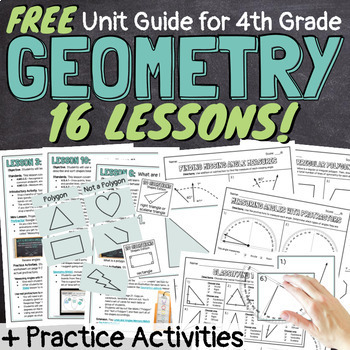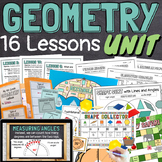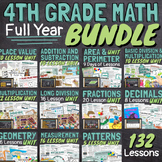FREE 4th Grade Geometry 16 Lessons Unit Guide with Worksheets and Activities
- PDF
Also included in
- This complete geometry math unit includes 16 easy to teach lessons that cover all 4th grade common core geometry standards (including geometric measurement standards). Skills taught include:identifying points, lines, line segments, rays, types of lines (parallel, perpendicular, intersecting), and tyPrice $32.85Original Price $54.75Save $21.90
- This year long fourth grade math bundle includes 132 math lessons spanning 11 different units. All lessons are common core aligned and cover all CCSS standards required for 4th grade math!Begin with each unit guide (these are free and linked below!). The lesson plans will walk you through each unitPrice $156.80Original Price $392.00Save $235.20
Description
This 4th grade geometry unit guide includes 16 lessons that cover all 4th grade common core geometry standards (including geometric measurement standards). It includes 9 practice worksheets, 3 hands on activities, discussion cards, a game, and a unit test (plus all answer keys).
Skills taught include:
- identifying points, lines, line segments, rays, types of lines (parallel, perpendicular, intersecting), and types of angles (acute, right, obtuse, straight)
- measuring and drawing angles using a protractor
- finding missing angle measures in adjacent angles (including complementary and supplementary angles)
- classifying types of triangles (acute, obtuse, right, equilateral, isosceles, scalene)
- classifying types of quadrilaterals (kite, trapezoid, parallelogram, rhombus, rectangle, square)
- classifying other polygons (pentagon, hexagon, heptagon, octagon, nonagon, decagon)
- regular vs. irregular polygons
- identifying lines of symmetry (symmetrical and asymmetrical shapes)
Note: Feel free to use these ideas, worksheets, practice activities, and assessments on their own. However, this unit guide is part of a 4th Grade Geometry Unit Bundle. You will want to purchase the bundle in order to gain access to the Google Slides lessons, games, and other projects and activities mentioned in the lesson plans.
Please follow my store here for more great resources!
You can also find me on Facebook, Instagram, and lafountaineofknowledge.com where you'll discover ideas, inspiration, and plenty of freebies! Or join my email list to get my monthly newsletter with exclusive FREE resources you can't get anywhere else!
Want free money to spend on Teachers Pay Teachers? Rate this product to earn some TpT credit! Leaving feedback helps us both out and takes less than a minute! Your support makes it possible for me to continue making and sharing great resources! Thank you!
Credits: The protractor clip art is by Clker-Free-Vector-Images, used with permission. All other graphics and photos were created by Shea LaFountaine of LaFountaine of Knowledge. Fonts used include Pangolin by Kevin Burke, and Londrina Solid and Londrina Shadow by Marcelo Magalhães. All fonts were used with permission under open source licenses.







